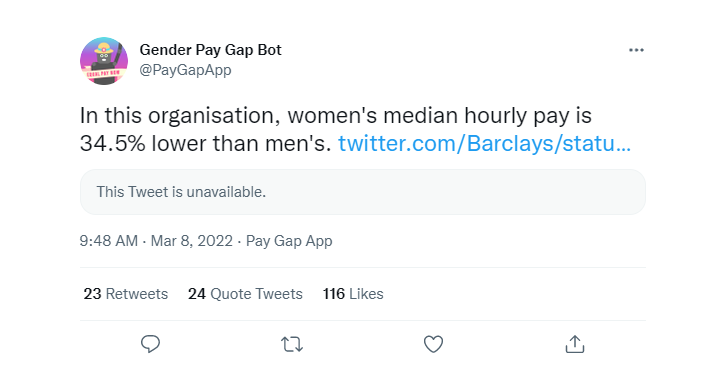
This is the second time I’ve taken on the task of writing the editor’s column at Morningstar – the first time, just before Christmas, I wanted to highlight the need for better diversity data. As we wrap up our International Women’s Day special report week, I repeat the plea.
I think I can speak for a lot of women when I say that International Women’s Day brings very conflicting feelings. It’s cause both for celebration and anger.
I love celebrating the achievements of women. Take a look at these five top-rated funds run by some amazing female fund managers. Or, read about the financial advisers who are going the extra mile to support not only their clients but a new generation of female financial experts. And these are the best women-run companies to own this year.
Celebrations aside, here are some reasons it’s reasonable to feel angry. Yes, #MeToo has changed the business risk of sexual misconduct, but change is happening very slowly. 97% of women in the UK have experienced some form of sexual harassment.
Pandemic Pain
It’s also still incredibly expensive to be female. As Jackie Porter highlighted earlier this week, women live longer – four years longer than men, on average. We also earn less, making it harder to save for retirement (the gender pensions gap in the UK was at 37.9% pre-pandemic), and, we carry the lion’s share of unpaid labour, including childcare and looking after elderly parents.
Moreover, the pandemic has hit women a lot harder than men, and non-white women face far higher unemployment than white women. In Canada, the unemployment rate for minority women was 10.5% in November, compared with 6.2% for white women, Statistics Canada revealed.
The World Economic Forum’s statistics also suggest that if gender equity polices prior to the pandemic remained intact in the workforce, women were not going to achieve parity for another 257 years. But if the gap has increased over the pandemic, who knows how many years have been added to the pile.
That’s not to say the pandemic has been all bad. Companies have realised that working from home is completely possible, allowing for a better work-life balance, but how much of this extra time are women using on household tasks or care work compared to men?
Becoming Botbait
In the workplace, conversations about diversity currently carry significant momentum. Businesses are conducting studies and surveys to understand impact, and I agree this is crucial to measure progress. But I’m not the only one wondering whether we actually are making any progress in making financial services in particular more inclusive.
In December, I said that I genuinely don’t want to go through another year of celebrating pretend strides taken to bring more women and people from minority backgrounds into the industry’s top roles. We are currently so far off the mark that, to improve opportunities for anyone not white cis-male, we need to talk about how influential the system is that promotes that group’s interests. Sometimes, we refuse to open our eyes and actually look.
IWD sadly often ends up being a day of performative activism and an advertising opportunity. Thankfully, this 8 March, a Twitter account named Gender Pay Gap Bot stepped up to call out companies choosing to tweet using the #IWD2022 hashtag. Its bio: “Employers, if you tweet about International Women's Day, I'll retweet your gender pay gap *eyes emoji*”. Several companies were left scrambling, and some ended up deleted their original tweets.

Twitter bots like that may come across as flippant or facetious, but they are so important. Diversity goes way beyond just having quotas to fill leadership roles with female managers (however, it is still key, and you can use this handy search tool to check the gender diversity of your favourite UK stock’s leadership).
Data Disaster
To my previous column, we do still need more data and analysis to measure the impact diversity has on a company. And don’t get me wrong: we don’t need to analyse whether having a female leadership improves performance – women and men are just as likely to do well in a leadership role, the problem is that women don’t get the same access.
Looking at the data we already have, there is evidence a lack of gender diversity is a human capital risk, and a material ESG issue for companies and their investors. Nor is diversity at board level a guarantee that gender policies will lead to an improvement in gender diversity and equality – just look at all the companies retweeted by Gender Pay Gap Bot. Barclays’ (which was among the companies that deleted their tweets) leadership is 29% female, and yet women's median hourly pay at the company is 34.5% lower than men's.
As Adam Fleck, director of ESG equity research at Morningstar, told my colleague Sara Silano earlier this week: “As boards are a step removed from the day-to-day activities and do not have contact with the workforce directly, board diversity may not be a signal or drive the aspiration for employees to progress within the company.”
Instead, what makes a difference is making sure the same opportunities for growth exist for all employees. What also matters is the degree of representation of diverse groups at multiple levels within an organisation that may contribute to lower employee turnover rates comparatively. Employees who get equal access to pathways for mobility are more likely to stay with a company, and the company will see increased diversity and equal representation across the organisation. It shouldn’t take a bot to point that out.
Sunniva Kolostyak is data journalist at Morningstar UK





























